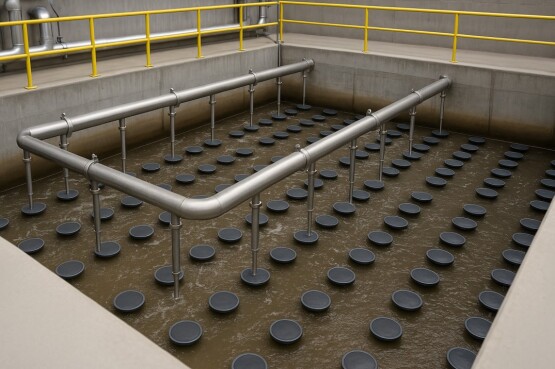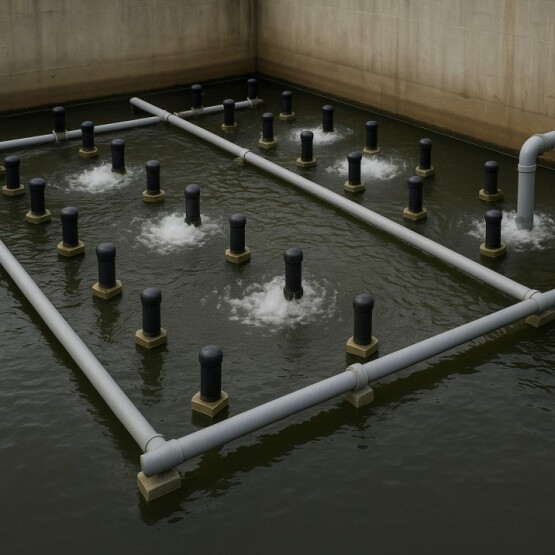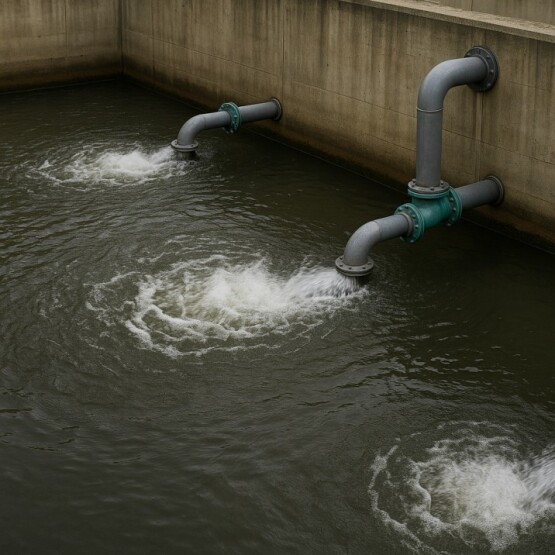Air Diffusers in Wastewater Treatment: Types and Benefits
Aeration is one of the most energy-intensive and critical processes in biological wastewater treatment. At the heart of effective aeration systems lie air diffusers — devices that deliver oxygen into the water, supporting microbial activity for the breakdown of organic matter. Choosing the right diffuser can significantly impact treatment efficiency, energy consumption, and long-term operational cost.
🔹 1. What Are Air Diffusers?
Air diffusers are porous devices, typically made from EPDM rubber, silicone, or ceramic, designed to release air into the wastewater in the form of bubbles.
These bubbles increase the surface area for gas exchange, allowing oxygen from the air to dissolve into the water — a critical requirement for aerobic biological processes.

🔹 2. Why Diffusers Matter
Oxygen Transfer Efficiency (OTE): Fine bubble diffusers produce smaller bubbles with higher surface area, which improves oxygen transfer.
Energy Optimization: Efficient diffusers reduce the amount of air (and thus energy) needed for proper aeration.
Process Stability: Uniform distribution of bubbles helps maintain even biological activity throughout aeration tanks.
Sludge Control: Proper aeration reduces sludge bulking and improves floc formation.
🔹 3. Types of Air Diffusers
1. Fine Bubble Diffusers
Produce bubbles 1–3 mm in diameter
Offer high oxygen transfer efficiency
Ideal for activated sludge systems, MBBR, and extended aeration tanks
Common shapes:
Disc diffusers (flat, round)
Tube diffusers (cylindrical)
Panel diffusers (large surface area, used in deep tanks)
2. Coarse Bubble Diffusers
Produce larger bubbles (3–10 mm)
Lower OTE but higher resistance to clogging
Often used in:
Equalization tanks
Grit removal basins
Sludge holding tanks
3. Jet Aerators
Mix water and air at high velocity
Efficient in deep tanks or industrial applications with high organic loads
Require more energy, but offer excellent mixing


🔹 4. Key Considerations When Selecting Diffusers
When choosing an air diffuser system, consider the following factors:
Oxygen demand of the treatment process
Tank depth and shape
Type of wastewater (municipal vs. industrial)
Clogging potential and cleaning needs
Membrane material durability
Compatibility with blower system
Always match diffuser type with process design to avoid energy waste and performance loss.

🔹 5. Maintenance and Lifespan
Fine bubble membranes typically last 5–8 years depending on water quality and cleaning schedule.
Regular cleaning (CIP or air scouring) helps prevent scaling and biofouling.
Replaceable membranes allow for cost-effective long-term use without full unit replacement.
Conclusion
Air diffusers are a small but powerful component of wastewater treatment systems. From energy savings to process stability, the type of diffuser you choose can make a big difference in performance and cost.
Whether upgrading an old system or designing a new plant, selecting the right diffuser technology is essential for modern, efficient, and reliable operation.




